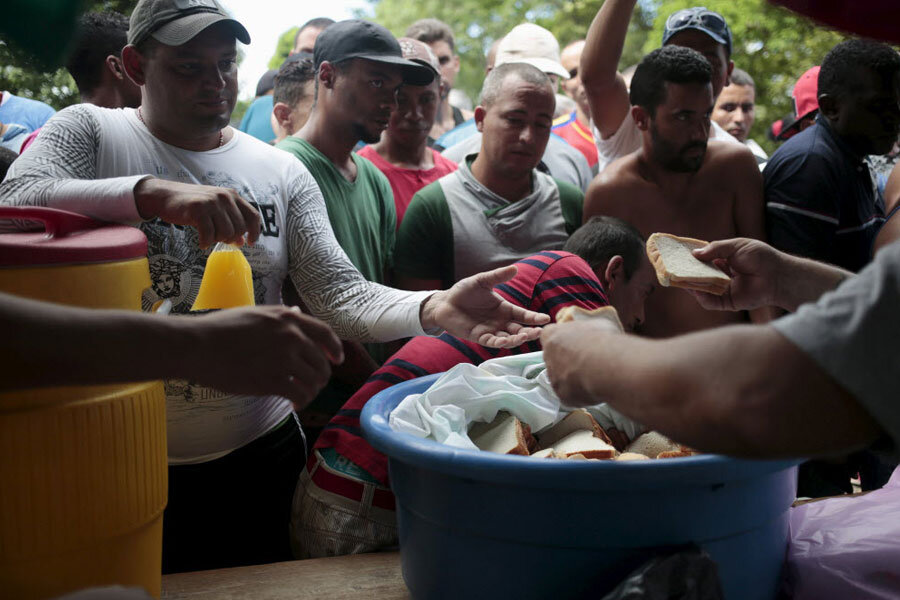As US-Cuba ties warm, Cuban migrants take overland route north
Loading...
| Paso Canoas, Costa Rica; and Mexico City
Hundreds of Cuban men, women, and children sit at a dusty bus station on Costa Rica’s southern border here on a recent afternoon, waiting for legal papers to transit the country.
They’re making their way to the United States, trying to get there while migration policies still favor Cubans. Although the White House says it has no plans to halt the so-called "wet-foot, dry-foot" policy that fast-tracks legal residency for Cubans on US territory, the Cuban government says the rule contradicts efforts between the two countries to normalize relations.
Since the US and Cuba restored diplomatic relations last December, the majority of citizens in both nations have welcomed the detente between cold war enemies. US vacationers are keen to visit the island and US companies are looking for trade deals.
Yet some Cubans seem to doubt that the benefits will soon flow their way. More than 27,000 Cuban migrants have entered the US between January and September this year, up nearly 80 percent over the same period last year.
“There’s a large cohort of Cubans that are frustrated,” says Jorge Duany, director of the Cuban Research Institute at Florida International University. “Especially younger people that don’t find a future in Cuba and don’t expect things to change substantially in the future, even though by all accounts Cubans are welcoming this new phase [with the US].”
Luis Rodríguez, a taxi driver from Havana who was waiting for papers Saturday in Paso Canoas, seemed unimpressed by the US-Cuban diplomatic thaw. “Politics is between the governments," he says. "For the people there’s nothing."
"We’re not interested in politics,” says Mr. Rodríguez’s older bother, Roberto. “We’re interested in food, work."
A long time coming?
Unlike in the past, when most Cuban migrants piled onto makeshift boats to reach US soil, this wave of migrants is taking a more circuitous and expensive route to avoid being caught and sent back. They typically fly first to Ecuador, one of the few nations in the region with visa-free travel for Cubans. From there, they continue overland, through Colombia, across Central America, into Mexico, and finally across the US border. The trip can cost between $5,000 and $15,000; police and gangs take their cut along the way.
Roberto Rodríguez, who also drives a taxi, says he decided to go overland because it was safer. "It's very dangerous [traveling by boat], bad weather. Anything can happen to you out there,” he says.
“Here, there are dangerous parts too, but,” it’s a calculated risk, he says.
Given the high cost of the trip, many of these migrants likely have relatives in the US or another country who can fund the journey, Mr. Duany says.
Jhoan Rodríguez, sitting with his family on a piece of cardboard at the border crossing, says the threat of US immigration policy change was a big motivator for his travel. He says he's hopeful that renewed diplomatic relations with the US will have an impact on the island – he's just not willing to wait and see.
"I think the hope of all Cubans is that this path leads to a better life for the Cuban people so they don’t have to" leave for the US in the future, he says.
But for Levi Fontaine, who is trying to make his way to Hialeah, Fla. to reunite with his father, he's been thinking about this journey for a while.
“The decision to leave Cuba didn’t start now. It started 10 years ago,” Mr. Fontaine says, referring to Cuba as "a prison.” He says wages back home were too low to make ends meet. His goal is to make enough money in the US to bring his mother and sister over from Cuba as well.
'Let's not talk about that'
In an echo of the much-larger refugee crisis in Europe, transit countries in Central America are feeling the pressure of the growing number of migrants from Cuba. On Sunday, Nicaragua shut its border with Costa Rica and deployed tear gas against those trying to cross.
Costa Rica also tried to tamp down on the flow of Cubans passing through earlier this month, announcing it would stop offering transit visas. However, as the population built up at its southern border with Panama, where an estimated 300 Cubans arrive daily, Costa Rica reversed course and said it would issue seven-day safe passage visas.
Back in Paso Canoas, those waiting to get into Costa Rica say they are set on reaching the US. When asked what he would do if he were stopped in another country on his way to the US and deported, the elder Rodríguez laughs, and then sighs: “Let’s not talk about that.”





